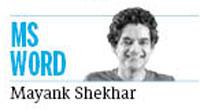Bangalore and Pune are 734 km apart. Never known distant cousins seem such Siamese twins. Why is that obvious?

Traffic snarls in Pune (left) and Bangalore. Pics/X
 What if you slipped into deep sleep in Pune, and woke up in Bangalore—would it feel the same? Depends on the gated township or neighbourhood you’re in, obviously.
What if you slipped into deep sleep in Pune, and woke up in Bangalore—would it feel the same? Depends on the gated township or neighbourhood you’re in, obviously.
Which could be Balewadi High Street in Pune—recent migrants/expats, bars, restaurants, all lined up, etc—that is Indiranagar in Bangalore? Are they what Bandra is to Bombay? Unsure. Or the good ol’ Koregaon Park is to Pune, what Koramangala is to Bangalore? Yes. Hence, what Colaba is to Bombay? No.
It’s clear to me: you can’t compare Pune and Bangalore to Bombay, or any other city. You can instantly compare them only to each other—primarily, as India’s post-liberalisation, stacked-up urban sprawls, for Pune as Maharashtra’s Bangalore!
They’re 734 kilometres apart. Never known distant cousins seem such siblings. Only, Bangalore = 3XPune. Since when did size matter better between sisters from other misters. How do they stand together in history?
As I obsess over a déjà vu, having woken up in the two cities, a weekend apart, it turns out, they once even had the same ruler, in the 1600s: Shahaji Bhosale, a military leader (fighting for Adil Shahi), who defeated Kempe Gowda III, to take over Bangalore. Shahaji had already inherited Pune from his Bhosale clan.
The British eventually came over. What did they bring, equally, to Pune and Bangalore? Their army cantonment, around which another city came up, making both pucca Indian military towns as well. Fit for ex-servicemen/officers to settle, with old civilians joining, turning both into India’s top retiree homes.
What did the government of free India do with Pune, and Bangalore? Headquarter several public sector establishments and research & development institutes. Along with PSUs, both cities are full of colleges. The largest number of colleges in India is in Bangalore. The university with the most affiliated colleges is in Pune.
Unsurprisingly, the ‘Tw-Indian’ cities on streets and pub crawls look younger than any. Also, with that many single people. You can tell this far more, anecdotally, from randomly scrolling on dating apps—wouldn’t surprise me a bit, if their consumer data reveals Bangalore and Pune (per capita) to be the singles’ capital of India (for all age groups, to be fair).
They take pride in their love for beer. Bangalore is, of course, where the national fizz, Kingfisher, comes from. The first time Bombayites heard of micro-breweries was from Doolally, off Pune.
Most Bangaloreans hold the potential to bore you with their snobbery around their favourite micro-brewery in town, or its crafted crap. You’d hear a lot more about Pune/B’lore rock bands/scene in the ’90s.
In the massive spaces for packed bars and nightclubs, Bollywood seems more the scene three decades later. Not that I mind, but we’ve a situation here! What else could it be if not the effect of North Indian migration?
For all its apparent cosmopolitanism, the Pune we experience is inherently a sleepy Maharashtrian town. Much as Bangalore is decidedly still a South Indian/Kannadiga city.
They branched out on steroids, simultaneously, in the late ’90s, with a boom in the infotech services’ industry. Anyone remembers the faux Y2K apocalypse looming over the world once? No, okay, I’m too old then!
That kinda explains Hinjawadi is to Pune, what Whitefield is to Bangalore. And so many other townships that open into dark, dirt tracks for city roads. Just bumping out of one called Bhartiya City (within a city).
Reading American public, I suspect, would’ve most famously encountered Bangalore as the global future, first, with columnist Tom Friedman extolling its virtues, in his bestseller, The World is Flat (2005)—awestruck by the Infosys campus in Electronic City. At least I was mesmerised, when much younger.
Bangalore’s Infosys became shining India’s finest story. Where was Infosys founded? Pune! The collegiate young, from across the country, I guess, were already in ‘Poonangalore’, or ‘Punengaluru’, to ride a wave with skill-based jobs, and stay on further. What followed? Well.
Bangalore became ‘Silicon Valley of India’. Pune was always ‘Oxford of the East’. Silicon Valley’s population: three million. Oxford: 1.5 lakh. Pune: over seven million. Bangalore: I guess, anywhere between 14 to 18 million.
Punengaluru got the greatness of big city thrust on a Tw-Indian town. Neither was meant to be a metropolis. State can’t catch up. Newcomers offer fewer incentives to politicians. Their votes emerge from elsewhere. Locals sense the brunt. Law-makers/enforcers, by all accounts, are the most corrupt in Bangalore—openly demanding their share of the new money.
Punekars have traditionally been stereotyped for their grouchiness. I find Bangaloreans, especially ones at the steering wheel, driving you to nowhere, particularly crabby. The quality of cabbies anyway can’t match the quantity of demand.
It takes me two hours to get through eight kilometres in Pune (fine; it’s Ganpati night). Bangaloreans perennially fret over traffic/distances, with plans to socialise: “Too far, too far…”
They close into their shells for self-sufficient neighbourhoods, ideally walking to work, bypassing the rest of the city. Fair enough. I suppose this is how yesterday’s future becomes today’s nightmare.
But then, there’s one more thing that unites Punengaluru! Talk to blokes in either city. Beyond all that complaining, they’ll suitably defend the chaos: “But, look at the weather!” Okay, for however long that lasts—we’re talking weather now.
Mayank Shekhar attempts to make sense of mass culture. He tweets @mayankw14
Send your feedback to mailbag@mid-day.com
The views expressed in this column are the individual’s and don’t represent those of the paper.
 Subscribe today by clicking the link and stay updated with the latest news!" Click here!
Subscribe today by clicking the link and stay updated with the latest news!" Click here!










